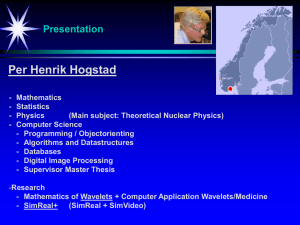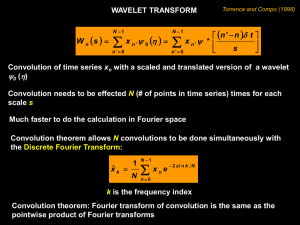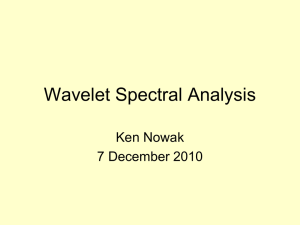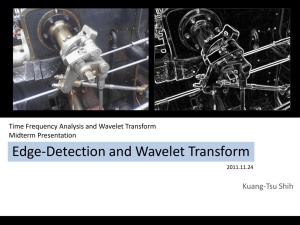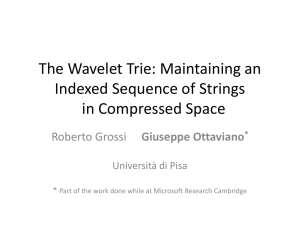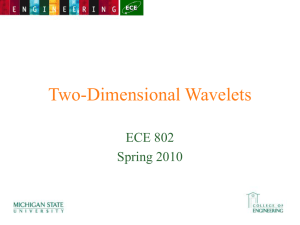Lecture 08
advertisement
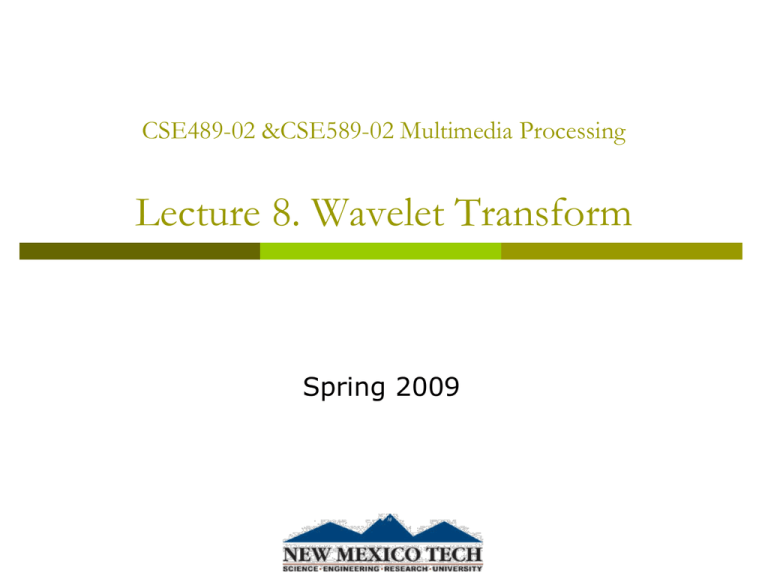
CSE489-02 &CSE589-02 Multimedia Processing
Lecture 8. Wavelet Transform
Spring 2009
Wavelet Definition
“The wavelet transform is a tool that cuts up data,
functions or operators into different frequency
components, and then studies each component
with a resolution matched to its scale”
Dr. Ingrid Daubechies, Lucent, Princeton U.
4/13/2015
2
Fourier vs. Wavelet
FFT, basis functions: sinusoids
Wavelet transforms: small waves, called wavelet
FFT can only offer frequency information
Wavelet: frequency + temporal information
Fourier analysis doesn’t work well on
discontinuous, “bursty” data
music, video, power, earthquakes,…
4/13/2015
3
Fourier vs. Wavelet
►
Fourier
Loses time (location) coordinate completely
Analyses the whole signal
Short pieces lose “frequency” meaning
►
Wavelets
Localized time-frequency analysis
Short signal pieces also have significance
Scale = Frequency band
4/13/2015
4
Fourier transform
Fourier transform:
4/13/2015
5
Wavelet Transform
Scale and shift original waveform
Compare to a wavelet
Assign a coefficient of similarity
4/13/2015
6
Scaling-- value of “stretch”
Scaling a wavelet simply means stretching (or
compressing) it.
f(t) = sin(t)
scale factor1
4/13/2015
7
Scaling-- value of “stretch”
Scaling a wavelet simply means stretching (or
compressing) it.
f(t) = sin(2t)
scale factor 2
4/13/2015
8
Scaling-- value of “stretch”
Scaling a wavelet simply means stretching (or
compressing) it.
f(t) = sin(3t)
scale factor 3
4/13/2015
9
More on scaling
It lets you either narrow down the frequency band of
interest, or determine the frequency content in a narrower
time interval
Scaling = frequency band
Good for non-stationary data
Low scaleCompressed wavelet Rapidly changing
detailsHigh frequency
High scale Stretched wavelet Slowly changing, coarse features
Low frequency
4/13/2015
10
Scale is (sort of) like frequency
Small scale
-Rapidly changing details,
-Like high frequency
Large scale
-Slowly changing
details
-Like low frequency
4/13/2015
11
Scale is (sort of) like frequency
The scale factor works exactly the same with wavelets.
The smaller the scale factor, the more "compressed"
the wavelet.
4/13/2015
12
Shifting
Shifting a wavelet simply means delaying (or hastening) its
onset. Mathematically, delaying a function f(t) by k is
represented by f(t-k)
4/13/2015
13
Shifting
C = 0.0004
C = 0.0034
4/13/2015
14
Five Easy Steps to a Continuous Wavelet
Transform
1. Take a wavelet and compare it to a section at the start of
the original signal.
2. Calculate a correlation coefficient c
4/13/2015
15
Five Easy Steps to a Continuous Wavelet
Transform
3. Shift the wavelet to the right and repeat steps 1 and 2 until you've
covered the whole signal.
4. Scale (stretch) the wavelet and repeat steps 1 through 3.
5. Repeat steps 1 through 4 for all scales.
4/13/2015
16
Coefficient Plots
4/13/2015
17
Discrete Wavelet Transform
“Subset” of scale and position based on power of
two
rather than every “possible” set of scale and
position in continuous wavelet transform
Behaves like a filter bank: signal in, coefficients
out
Down-sampling necessary
(twice as much data as original signal)
4/13/2015
18
Discrete Wavelet transform
signal
lowpass
highpass
filters
Approximation
(a)
4/13/2015
Details
(d)
19
Results of wavelet transform
— approximation and details
Low frequency:
approximation (a)
High frequency
details (d)
“Decomposition”
can be performed
iteratively
4/13/2015
20
Wavelet synthesis
•Re-creates signal from coefficients
•Up-sampling required
4/13/2015
21
Multi-level Wavelet Analysis
Multi-level wavelet
decomposition tree
4/13/2015
Reassembling original signal
22
2-D 4-band filter bank
Approximation
Vertical detail
Horizontal detail
Diagonal details
4/13/2015
23
An Example of One-level Decomposition
4/13/2015
24
An Example of Multi-level Decomposition
4/13/2015
25
Wavelet Series Expansions
Wavelet series expansion of function f ( x ) L2 ( )
relative to wavelet ( x) and scaling function ( x)
f ( x) c j0 ( k ) j0 ,k ( x) d j ( k ) j ,k ( x)
k
j j0
k
where ,
c j0 (k ) : approximation and/or scaling coefficients
d j (k ) : detail and/or wavelet coefficients
4/13/2015
26
Wavelet Series Expansions
c j0 (k ) f ( x), j0 ,k ( x) f ( x) j0 ,k ( x)dx
and
d j (k ) f ( x), j ,k ( x) f ( x) j ,k ( x)dx
4/13/2015
27
Wavelet Transforms in Two Dimensions
( x, y ) ( x) ( y )
( x, y ) ( x) ( y )
j ,m,n ( x, y ) 2 j /2 (2 j x m, 2 j y n)
( x, y ) ( x) ( y )
i j ,m,n ( x, y ) 2 j /2 i (2 j x m, 2 j y n)
D ( x, y ) ( x) ( y )
i {H ,V , D}
H
V
1
W ( j0 , m, n)
MN
W i ( j , m, n)
1
MN
M 1 N 1
f ( x, y)
x 0 y 0
M 1 N 1
x 0 y 0
j0 , m, n
( x, y)
f ( x, y ) i j ,m,n ( x, y )
i H ,V , D
4/13/2015
28
Inverse Wavelet Transforms in Two Dimensions
1
f ( x, y )
W ( j0 , m, n) j0 ,m,n ( x, y )
MN m n
1
i
i
W ( j , m, n) j ,m,n ( x, y )
MN i H ,V , D j j0 m n
4/13/2015
29
